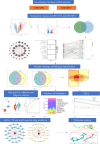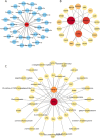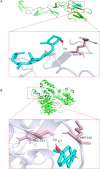Elucidating common biomarkers and pathways of osteoporosis and aortic valve calcification: insights into new therapeutic targets
- PMID: 39537712
- PMCID: PMC11560947
- DOI: 10.1038/s41598-024-78707-6
Elucidating common biomarkers and pathways of osteoporosis and aortic valve calcification: insights into new therapeutic targets
Abstract
Background: Osteoporosis and aortic valve calcification, prevalent in the elderly, have unclear common mechanisms. This study aims to uncover them through bioinformatics analysis.
Methods: Microarray data from GEO was analyzed for osteoporosis and aortic valve calcification. Differential expression analysis identified co-expressed genes. SVM-RFE and random forest selected key genes. GO and KEGG enrichment analyses were performed. Immunoinfiltration and GSEA analyses were subsequently performed. NetworkAnalyst analyzed microRNAs/TFs. HERB predicted drugs, and molecular docking assessed targeting potential.
Results: Thirteen genes linked to osteoporosis and aortic valve calcification were identified. TNFSF11, KYNU, and HLA-DMB emerged as key genes. miRNAs, TFs, and drug predictions offered therapeutic insights. Molecular docking suggested 17-beta-estradiol and vitamin D3 as potential treatments.
Conclusion: The study clarifies shared mechanisms of osteoporosis and aortic valve calcification, identifies biomarkers, and highlights TNFSF11, KYNU, and HLA-DMB. It also suggests 17-beta-estradiol and vitamin D3 as potential effective treatments.
Keywords: Aortic valve calcification; Bioinformatics analysis; Machine learning; Molecular mechanisms; Osteoporosis.
© 2024. The Author(s).
Conflict of interest statement
Figures









Similar articles
-
Integrated bioinformatics analysis identified leucine rich repeat containing 15 and secreted phosphoprotein 1 as hub genes for calcific aortic valve disease and osteoarthritis.IET Syst Biol. 2024 Jun;18(3):77-91. doi: 10.1049/syb2.12091. Epub 2024 Apr 2. IET Syst Biol. 2024. PMID: 38566328 Free PMC article.
-
Exploring potential genes and pathways related to calcific aortic valve disease.Gene. 2022 Jan 15;808:145987. doi: 10.1016/j.gene.2021.145987. Epub 2021 Sep 30. Gene. 2022. PMID: 34600049
-
AVCAPIR: A Novel Procalcific PIWI-Interacting RNA in Calcific Aortic Valve Disease.Circulation. 2024 May 14;149(20):1578-1597. doi: 10.1161/CIRCULATIONAHA.123.065213. Epub 2024 Jan 23. Circulation. 2024. PMID: 38258575
-
Valve Interstitial Cells: The Key to Understanding the Pathophysiology of Heart Valve Calcification.J Am Heart Assoc. 2017 Sep 14;6(9):e006339. doi: 10.1161/JAHA.117.006339. J Am Heart Assoc. 2017. PMID: 28912209 Free PMC article. Review. No abstract available.
-
Conserved transcriptional regulatory mechanisms in aortic valve development and disease.Arterioscler Thromb Vasc Biol. 2014 Apr;34(4):737-41. doi: 10.1161/ATVBAHA.113.302071. Arterioscler Thromb Vasc Biol. 2014. PMID: 24665126 Free PMC article. Review.
References
-
- Cho, K. I., Sakuma, I., Sohn, I. S., Jo, S. H. & Koh, K. K. Inflammatory and metabolic mechanisms underlying the calcific aortic valve disease. Atherosclerosis. 277, 60–65 (2018). - PubMed
-
- Kanwar, A., Thaden, J. J. & Nkomo, V. T. Management of patients with aortic valve stenosis. Mayo Clin. Proc.93, 488–508 (2018). - PubMed
-
- Consensus development conference: Diagnosis, prophylaxis, and treatment of osteoporosis. Am. J. Med. 94, 646–650 (1993). - PubMed
MeSH terms
Substances
Supplementary concepts
Grants and funding
LinkOut - more resources
Full Text Sources
Medical
Research Materials

